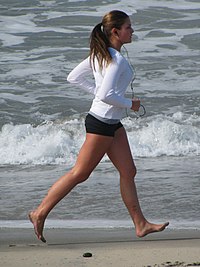
Photo from wikipedia
The aim of the study was to determine whether habitual minimalist shoe runners present with purported favorable running biomechanithat reduce running injury risk such as initial loading rate. Eighteen minimalist… Click to show full abstract
The aim of the study was to determine whether habitual minimalist shoe runners present with purported favorable running biomechanithat reduce running injury risk such as initial loading rate. Eighteen minimalist and 16 traditionally cushioned shod runners were assessed when running both in their preferred training shoe and barefoot. Ankle and knee joint kinetics and kinematics, initial rate of loading, and footstrike angle were measured. Sagittal ankle and knee joint stiffness were also calculated. Results of a two-factor ANOVA presented no group difference in initial rate of loading when participants were running either shod or barefoot; however, initial loading rate increased for both groups when running barefoot (p=0.008). Differences in footstrike angle were observed between groups when running shod, but not when barefoot (minimalist:8.71±8.99 vs. traditional: 17.32±11.48 degrees, p=0.002). Lower ankle joint stiffness was found in both groups when running barefoot (p=0.025). These findings illustrate that risk factors for injury potentially differ between the two groups. Shoe construction differences do change mechanical demands, however, once habituated to the demands of a given shoe condition, certain acute favorable or unfavorable responses may be moderated. The purported benefits of minimalist running shoes in mimicking habitual barefoot running is questioned, and risk of injury may not be attenuated.
Journal Title: International journal of sports medicine
Year Published: 2017
Link to full text (if available)
Share on Social Media: Sign Up to like & get
recommendations!